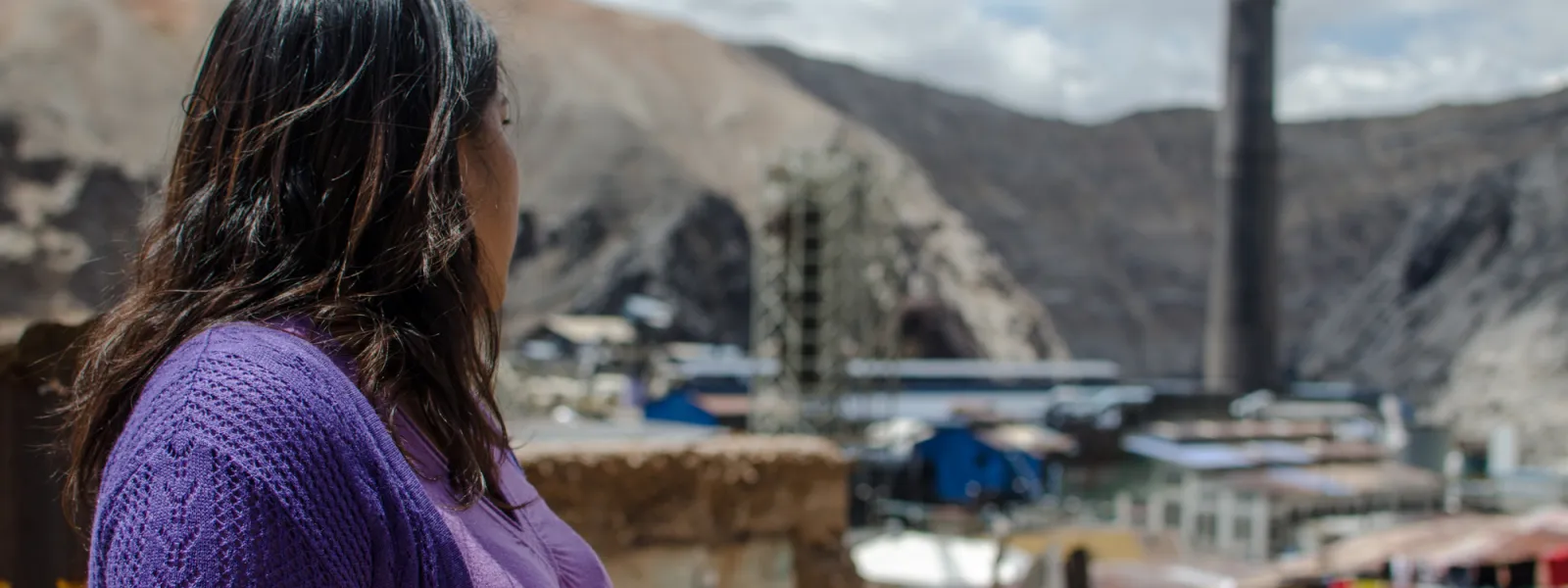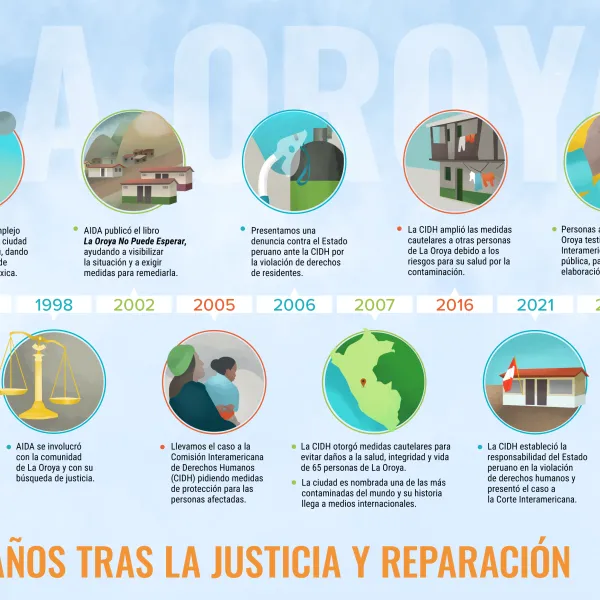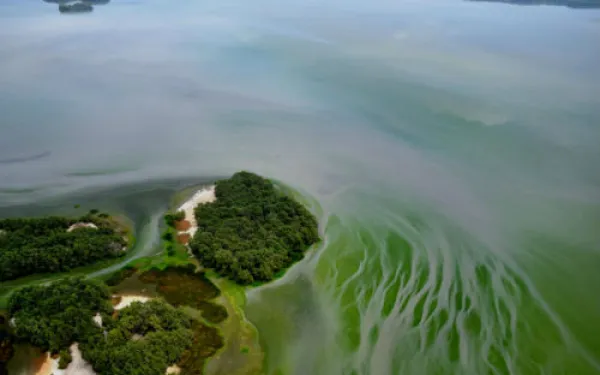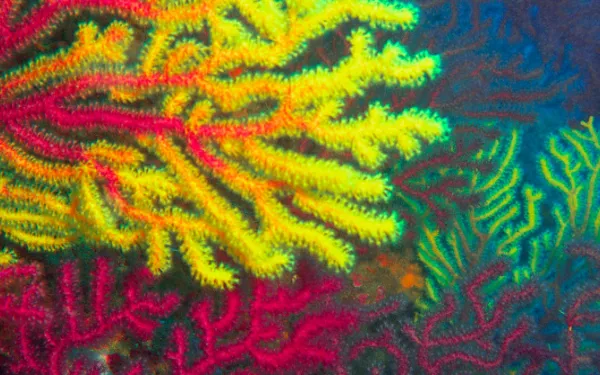
Project
Luchando por justicia para víctimas de contaminación tóxica en La Oroya, Perú
Por más de 20 años, residentes de La Oroya buscan justicia y reparación por la violación de sus derechos fundamentales a causa de la contaminación con metales pesados de un complejo metalúrgico y de la falta de medidas adecuadas por parte del Estado.
El 22 de marzo de 2024, la Corte Interamericana de Derechos Humanos dio a conocer su fallo en el caso. Estableció la responsabilidad del Estado de Perú y le ordenó adoptar medidas de reparación integral. Esta decisión es una oportunidad histórica para restablecer los derechos de las víctimas, además de ser un precedente clave para la protección del derecho a un ambiente sano en América Latina y para la supervisión adecuada de las actividades empresariales por parte de los Estados.
Antecedentes
La Oroya es una ciudad ubicada en la cordillera central de Perú, en el departamento de Junín, a 176 km de Lima. Tiene una población aproximada de 30.533 habitantes.
Allí, en 1922, la empresa estadounidense Cerro de Pasco Cooper Corporation instaló el Complejo Metalúrgico de La Oroya para procesar concentrados de minerales con altos niveles de plomo, cobre, zinc, plata y oro, así como otros contaminantes como azufre, cadmio y arsénico.
El complejo fue nacionalizado en 1974 y operado por el Estado hasta 1997, cuando fue adquirido por la compañía estadounidense Doe Run Company a través de su filial Doe Run Perú. En 2009, debido a la crisis financiera de la empresa, las operaciones del complejo se suspendieron.
Décadas de daños a la salud pública
El Estado peruano —debido a la falta de sistemas adecuados de control, supervisión constante, imposición de sanciones y adopción de acciones inmediatas— ha permitido que el complejo metalúrgico genere durante décadas niveles de contaminación muy altos que han afectado gravemente la salud de residentes de La Oroya por generaciones.
Quienes viven en La Oroya tienen un mayor riesgo o propensión a desarrollar cáncer por la exposición histórica a metales pesados. Si bien los efectos de la contaminación tóxica en la salud no son inmediatamente perceptibles, pueden ser irreversibles o se evidencian a largo plazo, afectando a la población en diversos niveles. Además, los impactos han sido diferenciados —e incluso más graves— entre niños y niñas, mujeres y personas adultas mayores.
La mayoría de las personas afectadas presentó niveles de plomo superiores a los recomendados por la Organización Mundial de la Salud y, en algunos casos, niveles superiores de arsénico y cadmio; además de estrés, ansiedad, afectaciones en la piel, problemas gástricos, dolores de cabeza crónicos y problemas respiratorios o cardíacos, entre otros.
La búsqueda de justicia
Con el tiempo, se presentaron varias acciones a nivel nacional e internacional para lograr la fiscalización del complejo metalúrgico y de sus impactos, así como para obtener reparación ante la violación de los derechos de las personas afectadas.
AIDA se involucró con La Oroya en 1997 y desde entonces hemos empleado diversas estrategias para proteger la salud pública, el ambiente y los derechos de sus habitantes.
En 2002, nuestra publicación La Oroya No Puede Esperar ayudó a poner en marcha una campaña internacional de largo alcance para visibilizar la situación de La Oroya y exigir medidas para remediarla.
Ese mismo año, un grupo de pobladores de La Oroya presentó una acción de cumplimiento contra el Ministerio de Salud y la Dirección General de Salud Ambiental para la protección de sus derechos y los del resto de la población.
En 2006, obtuvieron una decisión parcialmente favorable del Tribunal Constitucional que ordenó medidas de protección. Pero, tras más de 14 años, no se tomaron medidas para implementar el fallo y el máximo tribunal no impulsó acciones para su cumplimiento.
Ante la falta de respuestas efectivas en el ámbito nacional, AIDA —junto con una coalición internacional de organizaciones— llevó el caso ante la Comisión Interamericana de Derechos Humanos (CIDH) y en noviembre de 2005 solicitó medidas cautelares para proteger el derecho a la vida, la integridad personal y la salud de las personas afectadas. Luego, en 2006, presentamos una denuncia ante la CIDH contra el Estado peruano por la violación de los derechos humanos de residentes de La Oroya.
En 2007, como respuesta a la petición, la CIDH otorgó medidas de protección a 65 personas de La Oroya y en 2016 las amplió a otras 15 personas.
Situación actual
Al día de hoy, las medidas de protección otorgadas por la CIDH siguen vigentes. Si bien el Estado ha emitido algunas decisiones para controlar de algún modo a la empresa y los niveles de contaminación en la zona, estas no han sido efectivas para proteger los derechos de la población ni para implementar con urgencia las acciones necesarias en La Oroya.
Esto se refleja en la falta de resultados concretos respecto de la contaminación. Desde la suspensión de operaciones del complejo en 2009, los niveles de plomo, cadmio, arsénico y dióxido de azufre no han bajado a niveles adecuados. Y la situación de las personas afectadas tampoco ha mejorado en los últimos 13 años. Hace falta un estudio epidemiológico y de sangre en los niños y las niñas de La Oroya que muestre el estado actual de la contaminación de la población y su comparación con los estudios iniciales realizados entre 1999 y 2005.
En cuanto a la denuncia internacional, en octubre de 2021 —15 años después de iniciado el proceso—, la CIDH adoptó una decisión de fondo en el caso y lo presentó ante la Corte Interamericana de Derechos Humanos tras establecer la responsabilidad internacional del Estado peruano en la violación de derechos humanos de residentes de La Oroya.
La Corte escuchó el caso en una audiencia pública en octubre de 2022. Más de un año después, el 22 de marzo de 2024, el tribunal internacional dio a conocer la sentencia del caso. En su fallo, el primero en su tipo, responsabiliza al Estado peruano por violar los derechos humanos de residentes de La Oroya y le ordena la adopción de medidas de reparación integral que incluyen remediación ambiental, reducción y mitigación de emisiones contaminantes, monitoreo de la calidad del aire, atención médica gratuita y especializada, indemnizaciones y un plan de reubicación para las personas afectadas.
Conoce los aportes jurídicos de la sentencia de la Corte Interamericana en el caso de La Oroya
Partners:

Proyectos relacionados

La Ciénaga Grande de Santa Marta
Quisiera dedicar este post a las personas que viven en y que trabajan por proteger La Ciénaga Grande de Santa Marta, Colombia. Hace unas semanas, gracias a Thomas Ankersen y Juan Pablo Sarmiento, aprendí sobre este sitio maravilloso que requiere protección urgente. El nombre oficial de este Parque Nacional es Santuario de Flora y Fauna Ciénaga Grande de Santa Marta. Está localizado entre Santa Marta y Barranquilla, pertenece a la jurisdicción de Sitio Nuevo. Es un humedal protegido por la Convención sobre los Humedales de Importancia Internacional (conocida como la Convención de Ramsar), un tratado internacional que sirve de "marco para la acción nacional y la cooperación internacional para la conservación y el uso racional de los humedales y sus recursos". Caracterizada por su rica diversidad de flora y fauna, La Ciénaga Grande alberga mamíferos como el ponche (Hydrochaerishydrochaeris) y la zorra manglera (Procyon lotor); reptiles como la tortuga icotea (Chrysemys scripta) y el caimán aguja (Crocodylus acutus); aves como el pato cuervo o longuillo (Phalacrocorax olivaceus olivaceus) y el pato aguja (Anhinga anhinga); y 53 especies de fauna íctica (peces presentes en un determinado lugar marino o fluvial); entre mucha otra variedad de fauna. Además, los bosques de manglar y húmedal que caracterizan la flora del lugar proveen beneficios incalculables para Colombia y el mundo: una hectárea de manglar captura hasta 50 veces más dióxido de carbono que una de bosque. Otro rasgo de la Ciénaga Grande es que en ella hay; pueblos palafíticos (vivienda en el agua) que se extienden por 26,810 hectáreas protegidas por bosques de manglar y humedal. Las 2,500 personas que viven allí dependen de la pesca para subsistir y, en los últimos años, han enfrentado serios retos para capturar peces pues han habido brotes de matanza de peces. Cientos de ellos han aparecido muertos. Los pobladores sufren además la falta de acceso al agua dulce (ni siquiera potable), al sistema de salud y a la seguridad social. Ello guarda relación con el cierre de la entrada de agua potable por desvíos para beneficio de la agricultura. La falta total de agua potable y/o el limitado abastecimiento de ésta han afectado la salinidad del agua y la calidad de vida de los pobladores. La Ciénaga Grande ha marcado mis pensamientos desde hace semanas. Aparte de ser un sitio único por su riqueza biológica, las personas que viven allí son admirables y requieren con urgencia una mejora en sus condiciones de vida. En el 2000 superaron una masacre paramilitar que ha forjado aún más su carácter perseverante. Hoy en día, lo que muchos de nosotros damos por sentado: abrir el grifo y llenar un vaso con agua, o la posibilidad de llegar con un médico en 20 o 30 minutos, es un lujo en la vida diaria de estas 2,500 personas. A lo largo de los años, he visto como el derecho ambiental internacional puede ser utilizado para proteger la riqueza biológica y reducir los impactos que el daño ambiental puede causar en las personas. Estoy segura entonces que pronto escribiré contándoles avances sobre este sitio y sus admirables habitantes.
Leer más
La Protección de los Arrecifes de Coral en México
Este informe aborda la importancia de los arrecifes de coral en el mundo —particularmente en México— y explora casos de estudio. Describe tratados y obligaciones internacionales relevantes, y dirige la mirada a las mejores prácticas de los países de la región en busca de inspiración. Con este informe, AIDA busca dar a conocer a autoridades, manejadores de sitio y sociedad civil las amenazas a los arrecifes de coral y proporcionar una agenda de oportunidades para su protección. Las conclusiones del reporte apuntan a que el manejo inadecuado de los arrecifes de coral ocasiona la pérdida de los beneficios económicos que brindan. Y las recomendaciones surgen para que las autoridades nacionales, organizaciones de la sociedad civil e individuos apoyen el fortalecimiento de la legislación existente para proteger a los arrecifes. El cuerpo de recomendaciones que el informe contiene, proviene del análisis de la legislación actual y los compromisos internacionales que México adquirió con la firma de tratados ambientales para la conservación de los corales. Las acciones separadas ayudan a evitar la degradación de los arrecifes de coral, pero en conjunto constituyen un plan de acción. Estas acciones abarcan desde la creación de un consejo o comisión intersecre-tarial hasta la elaboración de una política nacional para la protección y conservación de los arrecifes coralinos. Descarga el informe
Leer másOrganizaciones solicitan que la CIDH inste al Estado colombiano a declarar la moratoria de proyectos minero-energéticos y a constituir una Mesa de Trabajo con afectados y autoridades
Pidieron también que la Comisión Interamericana de Derechos Humanos (CIDH) inste al Estado a atender adecuadamente a las víctimas de desplazamiento forzado a causa de la implementación de proyectos de "desarrollo" e intervenga para que se abra un proceso de diálogo entre víctimas y autoridades para adoptar soluciones efectivas al problema. Washington D.C, EE.UU. En una audiencia celebrada el lunes pasado ante la Comisión Interamericana de Derechos Humanos (CIDH) en el marco de su 153º Periodo de Sesiones, organizaciones y movimientos sociales solicitaron a este órgano internacional, instar al Estado Colombiano a reconocer el desplazamiento forzado a causa de la implementación de proyectos de "desarrollo" como una violación de derechos humanos que debe ser prevenida y atendida. Además pidieron verificar esta grave situación en los territorios impactados mediante una visita. Las organizaciones expresaron su profunda preocupación por la situación de riesgo en la que se encuentran personas y comunidades que defienden su territorio y entorno natural. Ello ha derivado en el asesinato de 13 personas, la desaparición de una y amenazas a 25 personas que defienden los ríos en el país, incluyendo el reciente asesinato del líder comunero del pueblo Nasa, opositores a la mina la Colosa y una grave amenaza a un gobernador indígena de Cordoba. Expusieron casos concretos en los que megaproyectos han destruido territorios, ecosistemas, culturas ancestrales, causando daños irreparables como contaminación y generando desplazamiento forzado de poblaciones. Los solicitantes presentaron ante la CIDH tres causas principales que favorecen el desplazamiento forzado por proyectos: 1. La estrecha relación entre el conflicto armado y la implementación de megaproyectos; 2. La flexibilización y violación de normas en la autorización e implementación de proyectos, y 3. Los impactos directos por la puesta en marcha de estos. Señalaron que la violencia sociopolítica ha facilitado la implementación de proyectos mineros e hidroeléctricos, provocando el éxodo de personas de sus territorios y la apropiación de los mismos por parte de empresas. “El paramilitar Salvatore Mancuso reconoció que tres mil personas de la zona de Córdoba fueron desplazadas porque necesitaban esas tierras libres para la construcción de represas y que había que abrirle paso a los megaproyectos”, denunciaron. Indicaron además que la ejecución de los megaproyectos en Colombia imposibilita los procesos de verdad, justicia, reparación y garantías de no repetición de las víctimas del conflicto armado y del desarrollo. Adicionalmente, señalaron que el Estado está haciendo uso arbitrario de figuras jurídicas legales como la declaratoria de utilidad pública para dar vía libre a estos proyectos, sin considerar los impactos en derechos humanos y en el ambiente, asuntos también de interés público, lo que en la práctica se ha convertido en un mecanismo de expropiación o despojo legal, y en consecuencia, causal de desplazamiento forzado. Los megaproyectos están afectando gravemente los territorios y las culturas ancestrales, causando daños irreparables como la contaminación ambiental que están provocando desplazamientos de poblaciones. Están causas, que han generado por lo menos 200.000 desplazados víctimas de la implementación de proyectos hidroeléctricos, fundamentan la petición realizada por las organizaciones de que sea declarada la moratoria de los megaproyectos de minería y de hidroeléctricas como única garantía de protección y prevención de mayores vulneraciones de los derechos, hasta tanto no se evalúe estructuralmente la política y se garanticen los derechos fundamentales de los afectados. Finalmente, las organizaciones pidieron la intervención de la CIDH para que en Colombia se instale de inmediato una Mesa Integrada, donde participen los afectados, con el propósito de debatir la política minero energética y construir un modelo que no propicie el desarraigo y responda a las necesidades de las comunidades, y tenga en cuenta las advertencias realizadas por la Corte Constitucional y la Contraloría General de la Republica sobre la necesidad de definir otras formas sustitutivas de generación de energía como las estipuladas por la Comisión Mundial para Represas.
Leer más